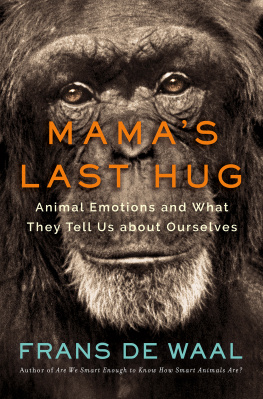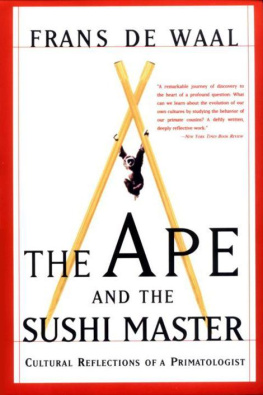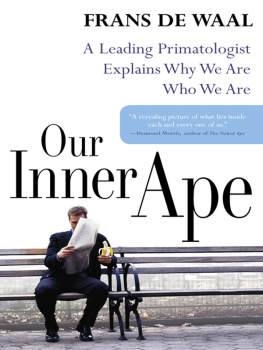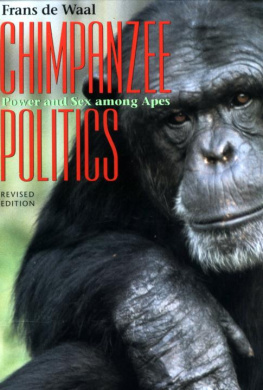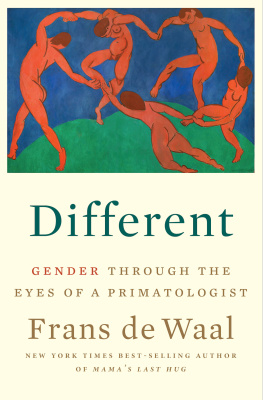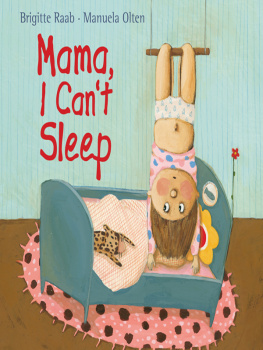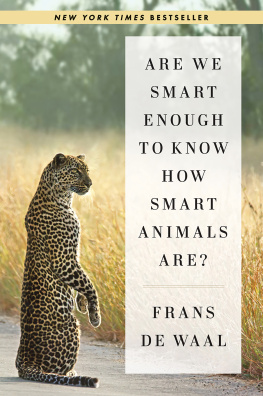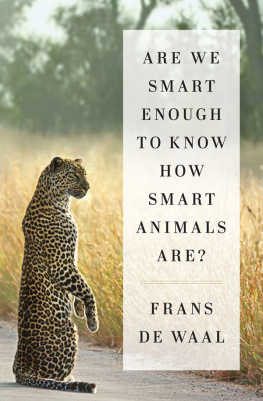
MAMAS LAST HUG
MAMAS
LAST HUG
ANIMAL EMOTIONS AND
WHAT THEY TELL US
ABOUT OURSELVES
Frans de Waal
With photographs and drawings by the author

W. W. Norton & Company
Independent Publishers Since 1923
New York London
For Catherine, who lights my fire
W atching behavior comes naturally to me, so much so that I may be overdoing it. I didnt realize this until I came home one day to tell my mother about a scene on a regional bus. I must have been twelve. A boy and girl had been kissing in the gross way that I couldnt relate to but that is typical of teenagers, with open mouths moistly clamped onto each other. This by itself was nothing special, but then I noticed the girl afterward chewing gum, whereas before the kiss I had seen only the boy chewing. I was puzzled but figured it outit was like the law of communicating vessels. When I told my mom, however, she was less than thrilled. With a troubled expression, she told me to stop paying such close attention to people, saying it was not a very nice thing to do.
Observation is now my profession. But dont expect me to notice the color of a dress or whether a man wears a hairpiecethose things dont interest me in the least. Instead, I focus on emotional expressions, body language, and social dynamics. These are so similar between humans and other primates that my skill applies equally to both, although my work mostly concerns the latter. As a student, I had an office overlooking a zoo colony of chimpanzees, and as a scientist at the Yerkes National Primate Research Center, near Atlanta, Georgia, I have had a similar situation for the last twenty-five years. My chimps live outdoors at a field station and occasionally get into upheavals that cause such a ruckus that we rush to the window to take in the spectacle. What most people will see as a chaotic melee of twenty hairy beasts running about hollering and screaming is in fact a highly ordered society. We recognize every ape by face, even just by voice, and know what to expect. Without pattern recognition, observation remains unfocused and random. It would be like watching a sport that youve never played and dont know much about. You basically see nothing. This is why I cant stand American television coverage of international soccer matches: most sports narrators came late to the game and fail to grasp its fundamental strategies. They have eyes for the ball only and keep on blabbing during the most pivotal moments. This is what happens when we lack pattern recognition.
Looking beyond the central scene is key. If one male chimpanzee intimidates another by throwing rocks or charging closely past the other, you need to deliberately take your eyes off them to check the periphery, where new developments arise. I call it holistic observation: considering the wider context. That the threatened males best buddy is asleep in a corner doesnt mean we can ignore him. As soon as he wakes up and walks toward the scene, the whole colony knows things are about to change. A female gives a loud hoot to announce the move, while mothers press their youngest offspring close.
And after the commotion has died down, you dont just turn away. You keep your eyes on the main actorsthey arent finished yet. Of the thousands of reconciliations Ive witnessed, one of the first took me by surprise. Shortly after a confrontation, two male rivals walked upright, on two legs, toward each other, fully pilo-erectmeaning their hair was standing on end, making them look twice their regular size. Their eye contact looked so fierce, I expected a revival of the hostilities. But when they got close to each other, one of them suddenly turned around and presented his behind. The other responded by grooming closely around the anus of the first male, uttering loud lip-smacks and tooth-clacks to indicate his dedication to the task. Since the first male wanted to do the same, they ended up in an awkward 69 position, which allowed each of them to groom the others behind at the same time. Soon thereafter they relaxed and turned around to groom each others faces. Peace was restored.
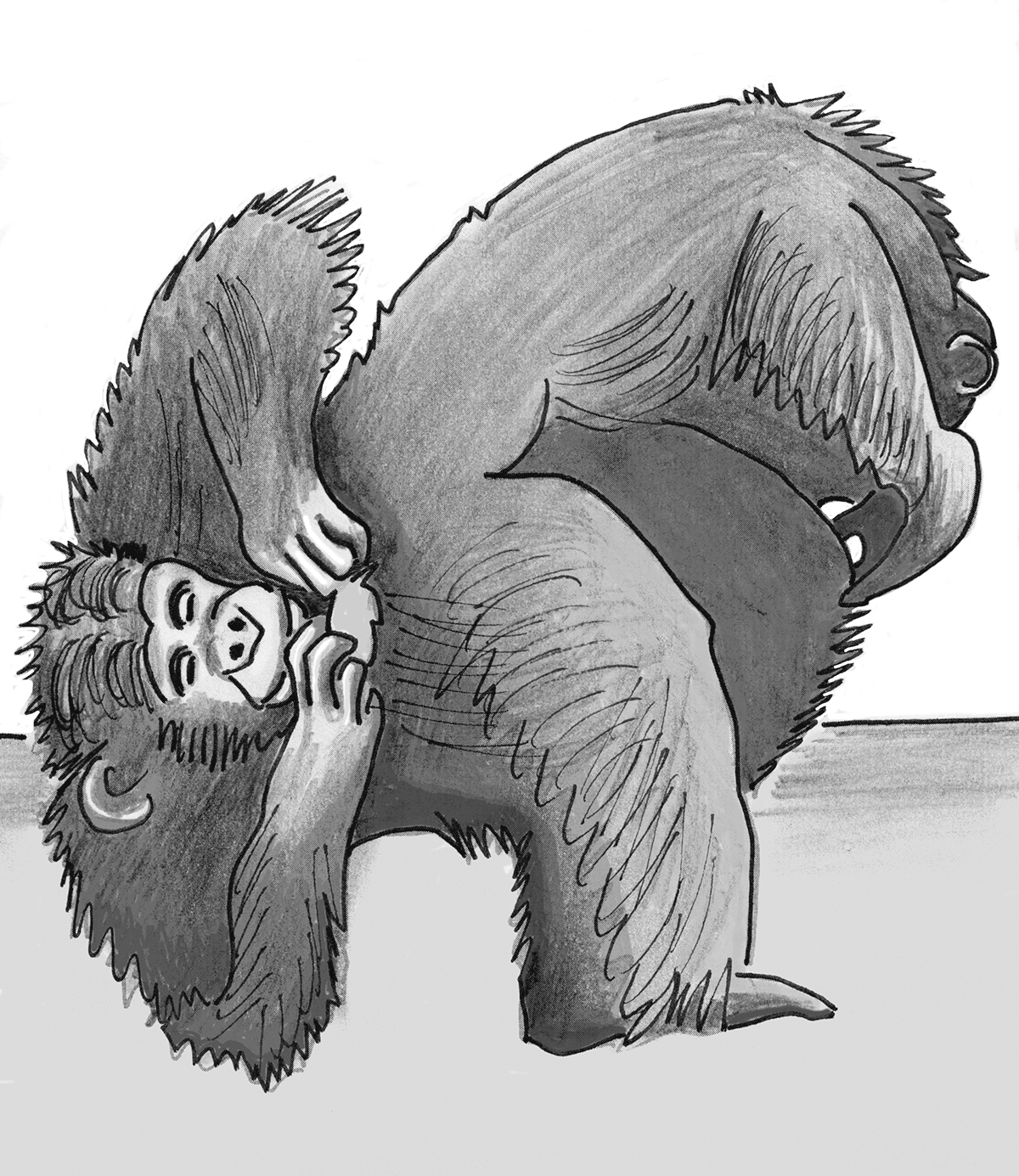
During reconciliations after fights, chimpanzee males are eager to groom their rivals behind, which may lead to awkward 69 positions if both of them try to do so at the same time.
The initial grooming location may seem odd, but remember that English (as well as many other languages) has expressions such as brown-nosing and ass-licking. Im sure there is a good reason. Among humans, intense fear may cause vomiting and diarrheawe say we crap our pants when were frightened. Thats also a common occurrence in apes, minus the pants. Bodily exits yield critical information. Long after a skirmish has ended, you may see a male chimpanzee casually stroll to the precise location in the grass where his rival had been sitting, only to bend down and take a sniff. Although vision is about as dominant a sense in chimpanzees as it is in us, smell remains critically important. In our species, too, as covert filming has demonstrated, after we shake hands with another person, especially someone of the same sex, we often scent our own hand. We lift it casually close to our face to gather a chemical whiff that informs us about the others disposition. We do so unconsciously, as we do so many things that resemble the behavior of other primates. Nevertheless, we like to see ourselves as rational actors who know what were doing, while we depict other species as automatons. Its really not that simple.
We are constantly in touch with our feelings, but the tricky part is that our emotions and our feelings are not the same. We tend to conflate them, but feelings are internal subjective states that, strictly speaking, are known only to those who have them. I know my own feelings, but I dont know yours, except for what you tell me about them. We communicate about our feelings by language. Emotions, on the other hand, are bodily and mental states from anger and fear to sexual desire and affection and seeking the upper handthat drive behavior. Triggered by certain stimuli and accompanied by behavioral changes, emotions are detectable on the outside in facial expression, skin color, vocal timbre, gestures, odor, and so on. Only when the person experiencing these changes becomes aware of them do they become feelings, which are conscious experiences. We show our emotions, but we talk about our feelings.
Take reconciliation, or a friendly reunion following a confrontation. Reconciliation is a measurable emotional interaction: to detect it, all you, as an observer, need is some patience to see what happens between former antagonists. But the feelings that accompany a reconciliationcontrition, forgiveness, reliefare knowable only to those who experience them. You may suspect that others have the same feelings as you, but you cant be sure even with respect to members of your own species. Someone may claim they have forgiven another person, for example, but can we trust this information? All too often, despite what they have told us, they bring up the affront in question on the first occasion that arises. We know our own inner states imperfectly and often mislead both ourselves and those around us. Were masters of fake happiness, suppressed fear, and misguided love. This is why Im pleased to work with nonlinguistic creatures. Im forced to guess their feelings, but at least they never lead me astray by what they tell me about themselves.
Next page
